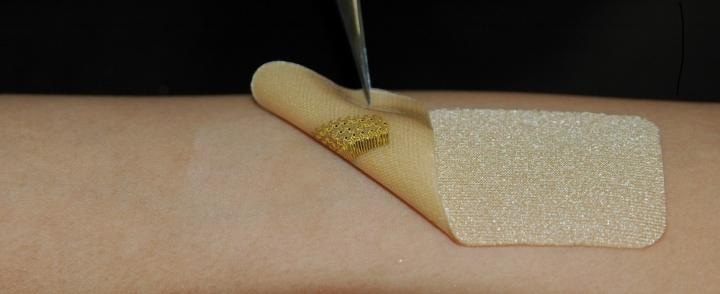Apr 3 2019
A novel skin-inspired electronics developed by a research team at Binghamton University, State University of New York, conforms easily to the skin and enables real-time, high-performance, and long-term wound monitoring in users.
 This is an image of the sensor on a textile-silicon bandage. (Image credit: Matthew Brown)
This is an image of the sensor on a textile-silicon bandage. (Image credit: Matthew Brown)
We eventually hope that these sensors and engineering accomplishments can help advance healthcare applications and provide a better quantitative understanding in disease progression, wound care, general health, fitness monitoring and more.
Matthew Brown, PhD Student, Department of Bioengineering, Binghamton University.
Biosensors, in essence, are analytical devices that integrate a physiochemical detector with a biological component to visualize and examine a chemical substance and its subsequent reaction within the body. Although traditional biosensor technology has made rapid strides in the medical field, it still has constraints to overcome and enhancements have to be made to improve their functionality. At the Intimately Bio-Integrated Biosensors lab of Binghamton University, scientists have created a novel, skin-inspired, open-mesh electromechanical sensor that has the potential to monitor oxygen and lactate levels on the skin.
We are focused on developing next-generation platforms that can integrate with biological tissue (e.g. skin, neural and cardiac tissue).
Matthew Brown, PhD Student, Department of Bioengineering, Binghamton University.
Under the direction of Ahyeon Koh, an Assistant Professor of Biomedical Engineering, Brown, master’s students Youjoong Park and Brandon Ashely, and undergraduate student Sally Kuan created a wearable sensor that is structured akin to that of the microarchitecture of the skin. This unique sensor is integrated with gold sensor cables that have the ability to display analogous mechanics to that of the elasticity of the skin.
The team is hoping to develop a novel mode of sensor that will blend flawlessly with the wearer's body to increase body analysis and thus help in inferring physiological and chemical data.
This topic was interesting to us because we were very interested in real-time, on-site evaluation of wound healing progress in a near future. Both lactate and oxygen are critical biomarkers to access wound-healing progression.
Matthew Brown, PhD Student, Department of Bioengineering, Binghamton University.
The researchers believe that upcoming studies will leverage this new skin-inspired sensor design to integrate additional biomarkers and fabricate sensors that are even more multifunctional to help with the process of wound healing. The investigators also hope to see these sensors being designed and incorporated into internal organs to achieve a better insight into various kinds of diseases that not only impact these organs but also affect the human body, as a whole.
The bio-mimicry structured sensor platform allows free mass transfer between biological tissue and bio-interfaced electronics. Therefore, this intimately bio-integrated sensing system is capable of determining critical biochemical events while being invisible to the biological system or not evoking an inflammatory response.
Ahyeon Koh, Assistant Professor, Department of Biomedical Engineering, Binghamton University.
The paper titled, “Skin-inspired, Open Mesh Electrochemical Sensors for Lactate and Oxygen Monitoring,” was published in Biosensors and Bioelectronics.